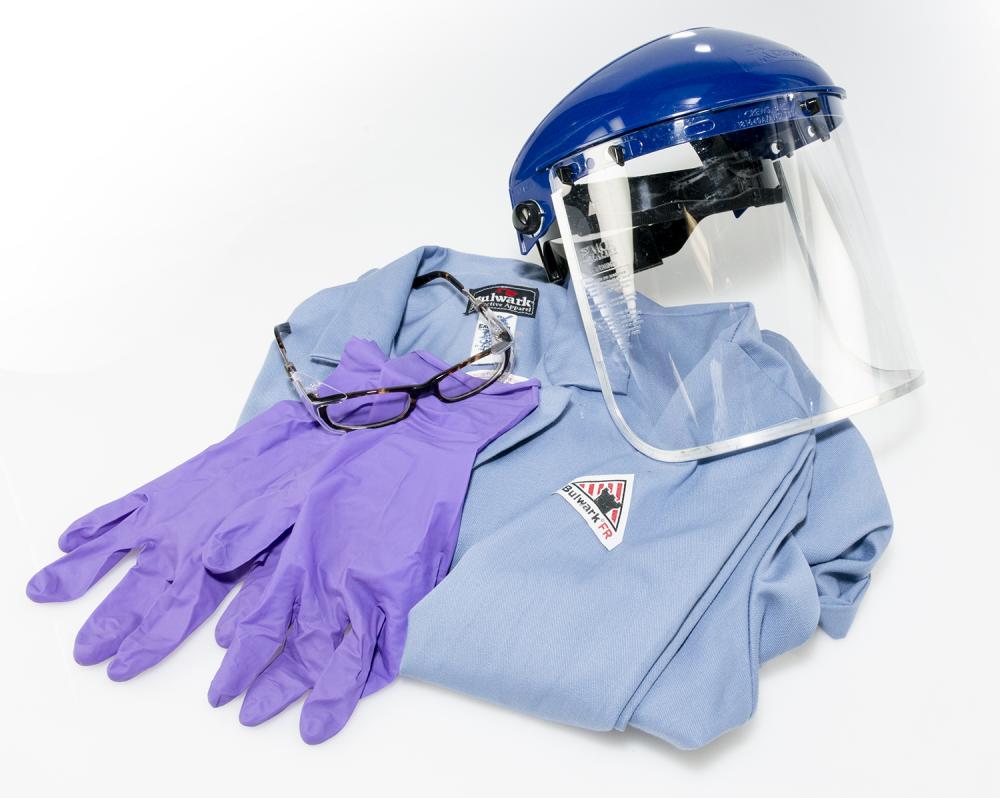By Ashley Shoemaker, Guest Writer
In January 2013, a revised policy on personal protective equipment (PPE) was approved for all government and contractor employees at NCI at Frederick. This new policy was driven by a high number of eye injuries at NCI at Frederick (56 between 2007 and 2012) that were directly related to inadequate PPE.
The Occupational Safety and Health Act states that each employer is responsible for identifying hazards in the workplace and determining what kind of PPE is necessary.
Injury-tracking data collected by the Environment, Health, and Safety (EHS) Directorate during the past five years indicates that the eye was the second-most-injured body part. A majority of these injuries occurred in the laboratory, many of them with seemingly “innocuous” and “nonhazardous” liquids, such as buffers, media waste, isopropyl and ethyl alcohols, and various other aqueous solutions. The medical response of flushing this type of exposure often leads to irritation or corneal abrasion, requiring prescription treatment, which creates an Occupational Safety and Health Administration (OSHA)-recordable injury.
The Bureau of Labor and Statistics estimates that 90 percent of eye injuries can be prevented through the use of proper protective eyewear on the job (http://ehs.okstate.edu/training/oshaeye.htm).
Quick Guide to the New Policy
The new policy states that if you work in a laboratory, animal facility, or GMP production area, you are required to wear, at minimum, a fully fastened lab coat (or facility clothing for animal facilities), safety glasses, appropriate gloves, and closed-toed shoes. This requirement also applies if you are observing an experiment or in the vicinity of another employee conducting work.
The only exception is for work that is purely administrative, such as using a computer, conversing with a colleague, or writing in a journal. When a hazard exists, you must don your PPE.
Lab coats must be fully fastened and appropriate for the work being conducted. Fire-resistant lab coats (marked “FR” on the label) must be worn when working with pyrophoric liquids, highly reactive chemicals, open flame processes, or large volumes (greater than 500 ml) of flammable solvents.
Safety glasses must be ANSI Z87.1-approved, and the approval must be marked on the eyewear. If you require prescription eyewear, you may obtain prescription glasses from the visiting optometrist, with a current (less than two years old) prescription. Prescription eyewear must also be ANSI Z87.1-approved and be equipped with approved side shields. You may wear a disposable face shield in conjunction with regular prescription glasses for operations that do not pose a flying object hazard.
A wide variety of gloves are available, depending on your particular needs. The amount of dexterity and the level of protection vary between gloves. Gloves must be selected to ensure adequate protection; however, most gloves are not designed to be immersed in, or have prolonged contact with, chemicals. Change gloves as soon as you are aware that they have been contaminated.
Surgical or examination gloves provide an adequate barrier for some tasks; however, specialized nitrile, butyl, or other types of gloves provide better protection when handling solvents, nonaqueous chemicals, and larger volumes. Latex gloves should be avoided, as they provide very limited chemical protection, and latex can cause sensitization and allergic response in the wearer.
No one glove will provide protection from all chemicals. You may consult the glove manufacturer’s recommendation charts via the Internet or call EHS for glove chemical compatibility.
Supervisors Take Note
Supervisors are responsible for ensuring that all employees have and are using their required PPE properly. OSHA requires supervisors to train their employees in the following:
- How to use PPE properly
- When wearing PPE is necessary
- What kind of PPE is required
- What the limitations are for each article of PPE
- How to put on and take off the PPE
- How to maintain PPE and dispose of it properly
The newly simplified PPE policy helps supervisors by ensuring that the basic level of PPE is easily understood and easy to enforce. Supervisors need to determine, however, when elevating this basic level of PPE is necessary.
If you have any questions regarding the use or selection of PPE, please contact EHS at 301-846-1451.
Links to More Information
The updated PPE Policy: http://home.ncifcrf.gov/ehs/uploadedFiles/C-11%20Personal%20Protective%20Equip(2).pdf
OSHA’s PPE Regulations: http://www.osha.gov/SLTC/personalprotectiveequipment/index.html
For prescription eyewear: http://home.ncifcrf.gov/ehs/uploadedFiles/Eyewear%20schedule%20for%20CY12.pdf
Ashley Shoemaker is an occupational safety specialist in the Environment, Health, and Safety Directorate.


